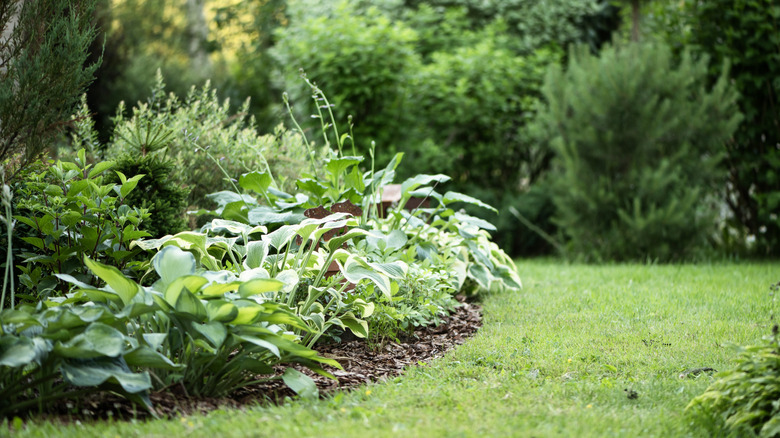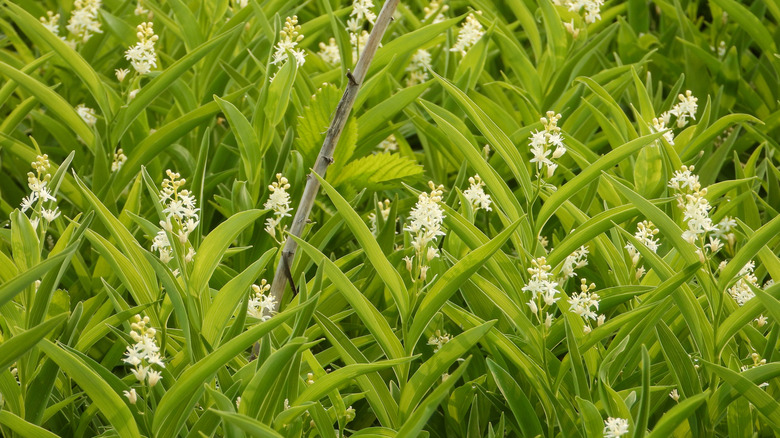Forget Hostas: This Plant Grows Well Anywhere In The Yard
When it comes to decorative landscaping plants, none are more sought-after than the hosta. In fact, according to the American Hosta Society, they are the most widely grown ornamental perennial in the United States. The many species and cultivars of hosta are widely available and beloved by gardeners, but hostas can be picky plants, and they are as popular with animals and insects as they are with people. If you're looking for a good alternative for temperamental hostas in your garden, starry Solomon's plume may be your answer.
Like hostas, Maianthemum stellatum, also known as starry Solomon's plume, starry false Solomon's seal, or starry false lily-of-the-valley, is a herbaceous perennial. While the colloquial names might make it sound duplicitous, the plant is not trying to copy Solomon's seal or lily-of-the-valley, they simply share a similar white flower and long leaf structure. Hostas grow in USDA Hardiness Zones 3 through 9, and starry Solomon's plume covers almost as much area, thriving in Zones 3 to 7. But unlike hostas, starry Solomon's plume is sun tolerant and shade tolerant — and less delicious to deer and snails. This tolerance allows you more versatility when it comes to planting locations in your yard.
Why gardeners choose starry Solomon's plume over hostas
Of the thousands of varieties of hostas, some are tolerant to the sun, but most require a shady environment to thrive. Hostas' love of shade is part of what makes them so appealing, but it can also be limiting, especially if you live in a sunny area or have a garden that sees as much sun as it does shade. You can plant starry Solomon's plume in all the same shady places you can plant hostas, but you can also grow it in the sunnier parts of your yard and leave that precious shade for plants that need it more.
Hostas are not invasive plants, but they're also not native. Imported from Japan, Korea, and China in the 1700s, hostas have grown in the U.S. for hundreds of years, but starry Solomon's plume is native to North America. So, those interested in embracing a natural lawn or gardeners seeking to attract more pollinators may have better luck. In warmer states like Arizona, hostas will not grow as well, as the plant requires weather below 40 degrees to enter a necessary dormant period in the winter. Starry Solomon's plume, on the other hand, can be found growing wild in the year-round warmth of California and Arizona, along with colder states like Missouri, making it easy to integrate into gardens across the U.S.
How to grow starry Solomon's plume in your garden
While starry Solomon's plume is an easy-going plant that can be grown anywhere in your yard, it still has some needs that must be met. In whatever part of your yard you choose to place it, make sure the soil is moist but well-draining. The plant is hardy and can tolerate a lot of different conditions — which is why it can grow well across much of North America — but it couldn't hurt to give it an extra boost. We recommend providing it with some sandy soil to mimic the riverbanks it grows near in nature.
Hostas are often used as a lush, low-maintenance ground cover, but starry Solomon's plume can fulfill that role just as well. Using its creeping rhizomes, it grows wide, expanding to reach a spread of around 18 inches. You do not need to prune it as it grows, but you can eat its springtime shoots, which are sometimes used as an asparagus substitute in meals.


